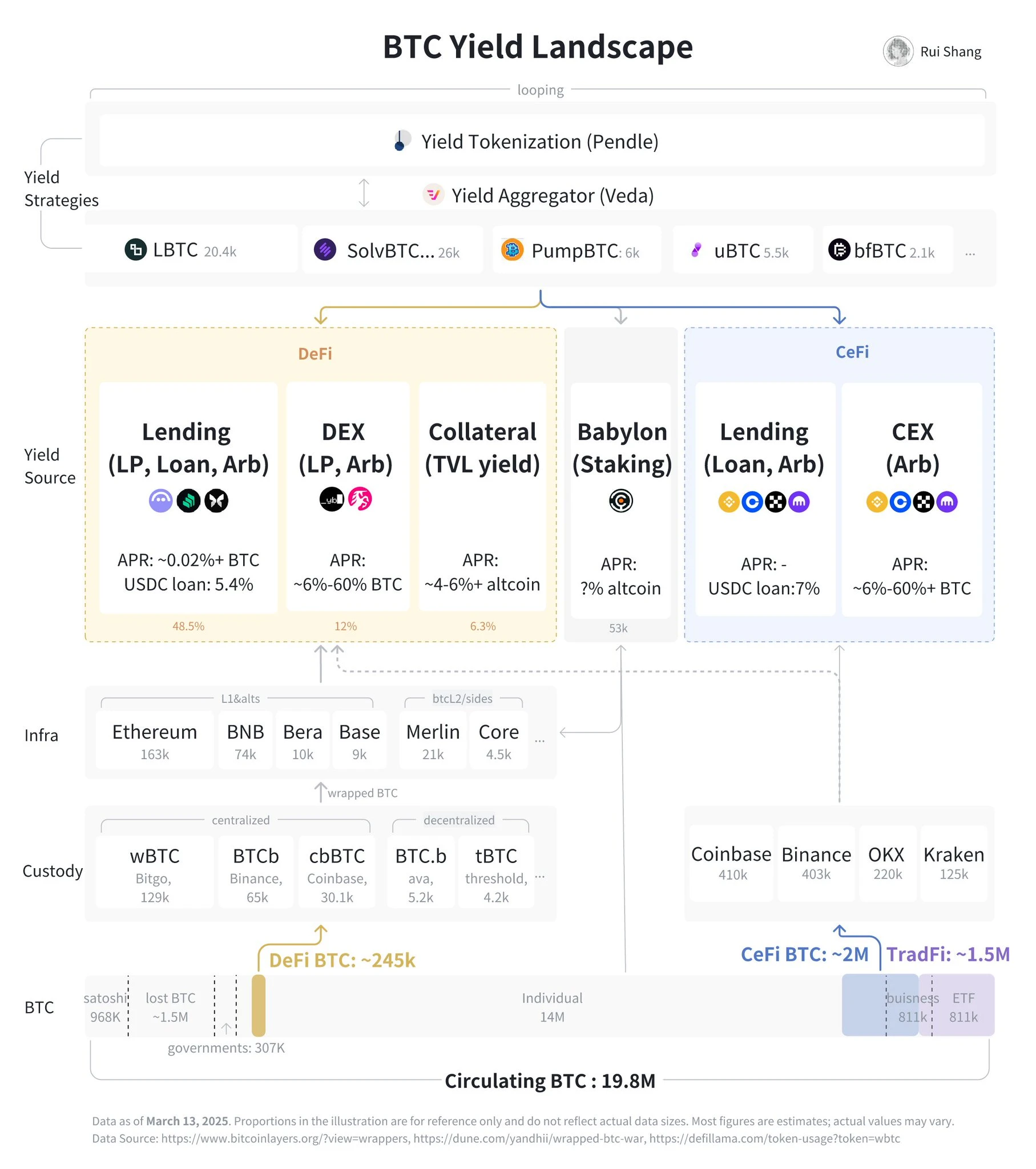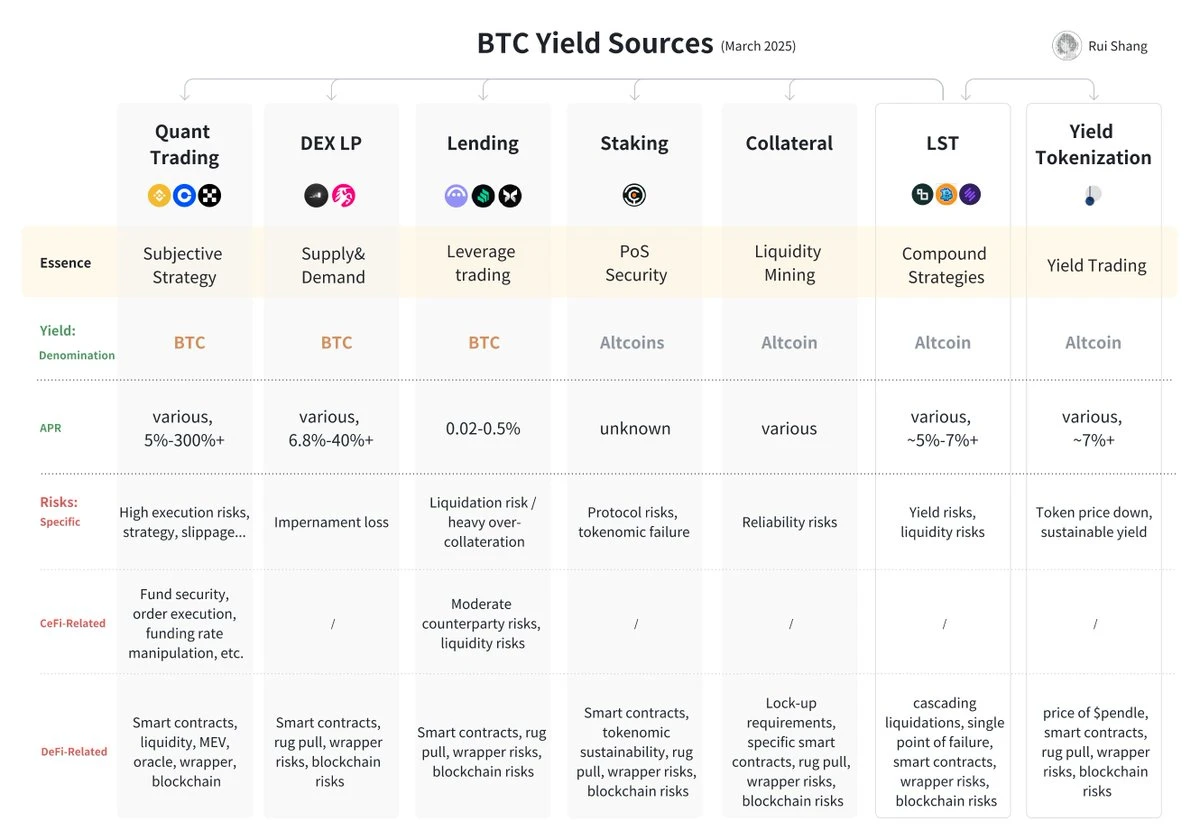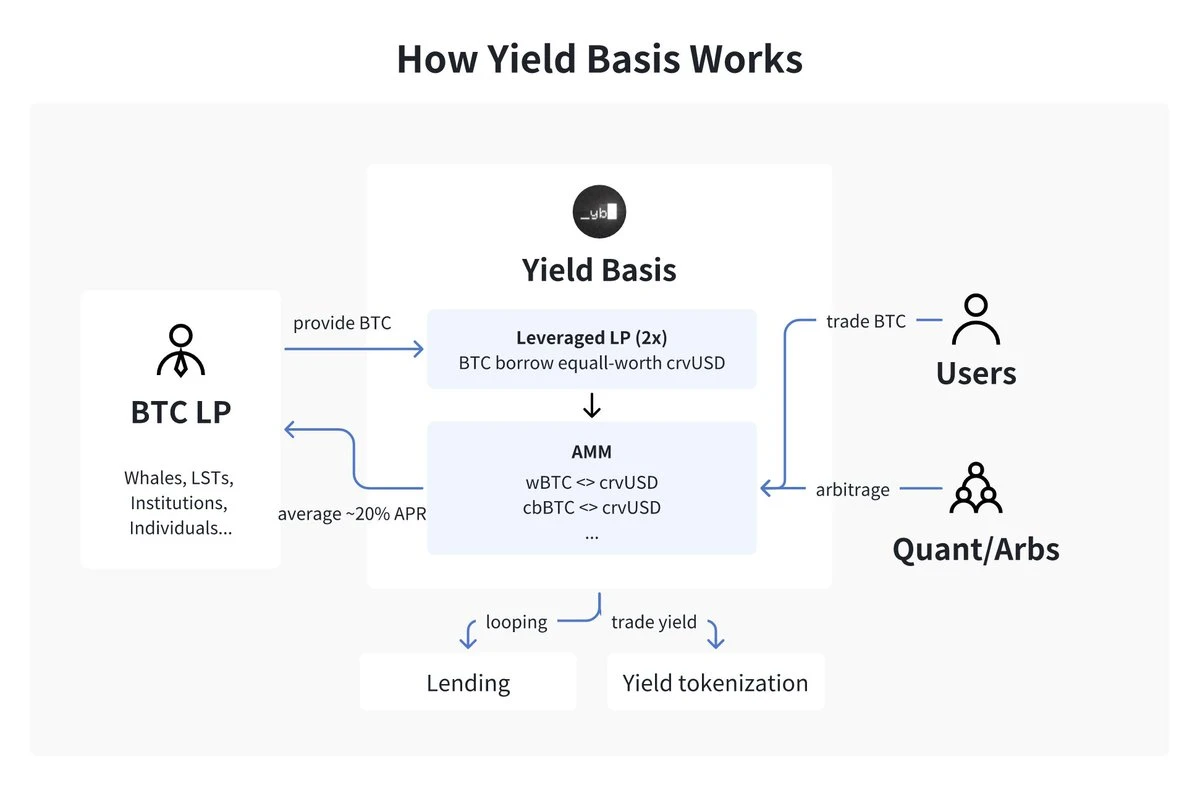A brief analysis of Curve's new founder Yield Basis: What other potential opportunities are available for BTC's revenue layer?

Reprinted from panewslab
03/28/2025·1MEditor's note: Curve Finance founder Michael Egorov launched a new project Yield Basis in February, which raised $5 million in funding at a valuation of $50 million tokens. SevenX Ventures investors wrote an article on the current status of BTC's revenue sources and analyzed the operation process of the Yield Basis protocol and the potential opportunities of the future BTC revenue layer. The following is the original content, compiled by Odaily Planet Daily:
BTC APR sounds tempting, but it could be a house of cards built on layers of altcoin incentives that can collapse at any time.
When faced with BTC APR, people usually ask some questions: Is the income settled in BTC or altcoins? What risks should we face? What is the potential principal loss? Is this benefit sustainable? Will it be diluted as TVL grows?
This article focuses on sustainable BTC settlement income in CeFi and DeFi, and is divided into three parts:
1. Original BTC income sources: quantitative transactions, DEX LP, lending, collateral, collateral, LST and Pendle;
2. New places for BTC income: Yield Basis agreement;
3. Outlook: Small mistakes can lead to catastrophic failures; scarcity of elite quantification teams; convergence of TradFi, CeFi and DeFi, and IPO opportunities.

Original BTC revenue sources
Although there are many ways to revolve and compound interest, we can divide the original income into five categories: quantitative trading, DEX LP, borrowing, pledge and collateral. (The following figure is a comparison chart of returns and risks)

1. Quantitative trading strategy: "Zerosum" game
Ensure your Alpha strategy net profit, arbitrage strategies include capital rates, spot futures base, cross-exchange and lending arbitrage, or involve event-driven transactions, quantitative trading requires deep liquidity – currently mainly on TradFi and CeFi. In addition, TradFi to DeFi arbitrage lacks cross-domain infrastructure.
BTC yield: varies according to asset size, risk profile and execution. The goal of a market neutral strategy may be 4-8% Bitcoin-based annual interest rate and a stop loss of about 1%. The best performing quantitative team even pursues an annual interest rate of 200-300%+ and performs complex risk control at stop loss of around 10-30%.
Risk: Very subjective, with model, judgment and execution risks – even neutral strategies can fall into directional bets. Real-time monitoring, strong infrastructure (such as latency, custody and delivery agreements), loss insurance and trading venue risk control are required.
2. DEX LP: Restricted by supply and demand
In addition to arbitrage, DEX also facilitates actual trading volume. Due to limited supply and demand, only about 3% of packaged BTC is currently in DEX. In more volatile LPing currency pairs (such as WBTC-USDC), supply is limited by impermanent losses, while demand faces wear and tear on packaged BTC and its limited utility in DeFi.
BTC yield: high volatility, Uniswap's current annual interest rate is 6.88%, up to double digits.
Risk: simply holding BTC is usually better than providing liquidity due to impermanent losses. However, new LPs are often misleading, reflecting a common psychological bias: expense gains and APR are obvious indicators that induce LPs to maximize short-term gains and ignore less obvious long-term capital loss, and DeFi risk applies to this.
3. Lending: BTC loan
BTC is primarily used as collateral for lending for USD or stablecoins for revolving or leveraged trading, rather than focusing on APR for lending BTC – because borrowing demand is currently low.
BTC yield: CeFi and DeFi loan interest rates are usually lower, around 0.02%-0.5% annual interest rates. LTV ratios for loans vary: TradFi 60-75% LTV currently has a preferential interest rate of 2-3%, CeFi 33-50% LTV currently has a USDC rate of 7%; DeFi LTV currently has a 33-67% USDC rate of 5.2%.
Risk: Liquidation risk, although low LTV ratios help reduce capital efficiency and hedging strategies can provide additional protection, there will be CeFi and DeFi risks.
4. Pledge: Earn altcoins rewards
Babylon is in a unique position where staking helps the security of the relevant PoS chains.
Altcoin income: denominated in altcoins, APR unknown.
Risk: The Babylon protocol should undergo multiple security audits and disclose the expected pledge income after the system is launched. If the Babylon token issuance is unsuccessful, the sustainability of the ecosystem will be at risk.
5. Collateral: Liquidity Mining
When you provide BTC to DeFi, BTC L2 and other protocols as TVL to earn altcoins.
Altcoin yields: vary, between about 5-7%, but giant whales always get better interest rates.
Risk: The reliability and verifiable records of the protocol vary, and each protocol has different lock-up periods and capital requirements.
6. Liquid staking tokens: compound income
BTC "LST" is similar to LST protocols such as Lombard, PumpBTC, Solv Protocol, and BitFi, which originate from the Babylon ecosystem. It is now a cross-chain BTC with complex revenue strategies. Among them, Veda is like an aggregator.
The income is mainly presented in the form of altcoins: combined with Babylon pledge rewards, points from different chains, Pendle, and some introduce quantitative strategies through third parties. In addition, it also provides its own tokens as an incentive.
Risk: LST has low liquidity and there is risk of chain liquidation. There is a single point of failure during casting, redemption, pledge and bridging. Relying heavily on the gains of altcoins from one's own and others indicates that the returns fluctuate greatly.
7. Earnings Tokenization: Earnings Trading
Pendle is the main platform for LST to earn more income, currently managing $444.17 million in BTC TVL, enabling traders to earn fixed income from principal (such as spot alternatives), hedge interest rate volatility, and obtain earning liquidity, long/short earnings positions.
Altcoin earnings: The yield may be unstable. YT holders can obtain the base income, exchange fees, fixed yield and PENDLE tokens of LST.
Risk: The decline in the price of PENDLE tokens will significantly affect participation. Pendle relies on sustainable yield volatility—it becomes tricky when most of its assets rely on multi-layer altcoin incentives, including Pendle itself.
New Place for BTC Income: Yield Basis

As mentioned above, while the yields denominated by altcoins are unsustainable, true BTC-based returns are scarce and risky. Quantitative teams require adequate liquidity, but DEX is not enough.
What is Yield Basis: YB is an automatic market maker (AMM) that minimizes impermanent losses and facilitates BTC LP, cross-country arbitrage and real trading.
BTC Earnings Base Layer: Based on data simulations over the past 6 years, YB can provide an average of 20% APR (net profit), which is even higher in a bull market. Additionally, it can be combined with any LST that wants to obtain actual BTC-based income exposure, and Pendle can work with the benefits generated by YB.
Places for complex trading strategies: Gradually establish a place with sufficient liquidity to conduct meaningful quantitative trading. It also provides a profitable compounding opportunity to increase the BTC lending rate in the lending agreement, which currently has $3.286 billion in WBTC on Aave, with a lending rate of about 0.02%.
Retail BTC trading venue: YB's long-term goal is to create the deepest on-chain liquidity for encapsulating BTC and compete with CeFi trading.
Mechanism: Solve impermanent losses
Mechanism: One AMM is embedded in another AMM
When a BTC LP is deposited to YB, it creates LP by borrowing half of the value of the LP and constantly re-levering it. This will create a stablecoin to the BTC pool with a rebalancing model, and the borrowing rate and 50% of the pool production costs will be used to rebalance the subsidy pool.
The APR is 2x pool yield (borrow rate + releverage loss), and the fixed cost is borrowed interest for crvUSD, which is controllable because the system will use it to get more profits. Higher volatility increases releverage losses, but also increases pool revenue, so the strategy remains valid unless volatility exceeds the selected maximum liquidity concentration. Parameter selection is crucial: more aggressive parameters can increase yields, but have a greater risk of releverage losses and vice versa.
How YB improves APR
LPs can choose to earn pool fees or stakes to earn YB tokens, and when the YB token is attractive, more LPs opt out of the pool, resulting in their higher APR.
Looking to the future
BTC revenue generation will become increasingly complex, with the focus on risk management, BTC-denominated and institutionalized products. Winners will be those who can provide deep liquidity and fair benefits without excessive exposure and innovate within the regulatory framework.
Small errors can lead to catastrophic losses
“Nothing is unbreakable – it’s just that it hasn’t been attacked yet.” BTC faces increasingly complex attacks from multiple risk levels: CEX trust delegates, self-hosted phishing, smart contract vulnerabilities (permissions, logic, algorithms) and mechanistic risks (liquidation, principal losses). Social engineering poses a serious threat by leveraging relationships and interfaces, and major BTC LPs even require chain pauses and bridge blocks. Although it sounds counterintuitive, public chains and highly liquid, licenseless agreements are not ideal for their security. Aquarius proposes a security framework that enables comprehensive testing, monitoring and risk tracking.
The scarcity of elite quantitative teams
Obviously, the real gains denominated in BTC are more attractive. While DEX LP is still in its infancy, quantitative trading still dominates. Some teams package their strategies into revenue-generating BTC products and raise funds from external LPs. However, the ability to high-frequency arbitrage may be limited, and top teams usually retain these strategies internally, reducing external capital – forming a "reverse choice". That being said, market neutral and other low-risk strategies make sense as productized BTC earnings products.
TradFi, CeFi and DeFi converge with IPO opportunities
As BTC liquidity continues to deepen, we witness the convergence of TradFi conservatism, CeFi accessibility and DeFi innovation. In January 2025, Coinbase launched Morpho Labs, a BTC-backed loan. Here is a signal: CeFi is implementing DeFi mechanisms for a wider audience. In this process, institutional-level asset management companies will have the opportunity to appear and may go public. Companies combining security-first infrastructure, transparent risk disclosure and trusted governance will build a strong brand that delivers the recurring revenue needed by TradFi asset managers and serves everything from high net worth clients to pensions and endowments.



 chaincatcher
chaincatcher